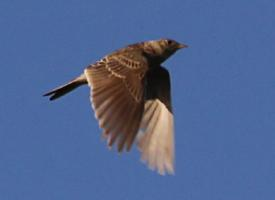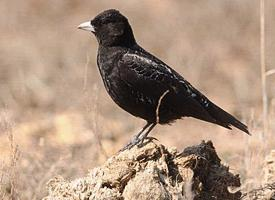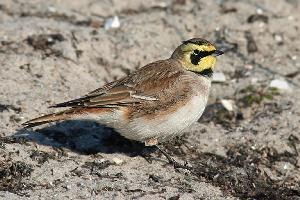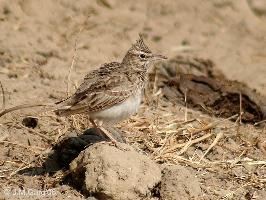
Poids et mesures
| Longueur | de 18 à 19 cm |
|---|
Description de l'animal
The Eurasian skylark (Alauda arvensis) is a small passerine bird species that belongs to the lark family, Alaudidae. It is renowned for its beautiful singing and is widely distributed across Europe and Asia, with some populations migrating to the southern parts of Africa in winter. This bird is highly adaptable, thriving in a variety of habitats, including open farmland, heathlands, and grasslands, making it a common sight across its range, though its numbers have been declining in some areas due to habitat loss and agricultural intensification.Physically, the Eurasian skylark is a compact bird, measuring about 16 to 18 centimeters in length and weighing between 20 to 45 grams. It has a relatively stout body, a short tail, and a small, pointed crest on its head, which it can raise or lower. The plumage of the Eurasian skylark is predominantly brown with blackish streaks, providing excellent camouflage against the ground. Its underparts are lighter, usually a pale buff or white, with distinct streaking on the breast. The wings are broad and rounded, and the tail is edged with white, which becomes visible during flight.
One of the most remarkable features of the Eurasian skylark is its song. Males are known for their spectacular singing flights, which can last for up to an hour. They ascend vertically into the air, reaching heights of up to 300 meters, and then hover, singing a continuous, melodious stream of trills, chirps, and whistles. This impressive display serves both to attract females and to mark their territory against rivals. The song is highly variable and can include mimicry of other bird species.
Eurasian skylarks are ground-nesting birds. Their nests are well-hidden in dense vegetation, constructed by the female from grasses and lined with finer materials. Females typically lay 3 to 6 eggs, which are incubated for about 11 days. The chicks are altricial, meaning they are born blind and featherless, and rely on their parents for food and warmth. Both parents feed the chicks, which fledge after 8 to 10 days but remain dependent on their parents for a few more weeks.
Their diet mainly consists of seeds and insects. During the breeding season, insects are crucial for feeding the chicks, providing the necessary protein for growth. In the colder months, the Eurasian skylark switches to a diet more heavily based on seeds and grains, often foraging in groups during this time.
Despite its wide range and once abundant numbers, the Eurasian skylark has experienced significant declines in parts of its range, primarily due to modern farming practices that reduce the availability of its natural habitats. Efforts to conserve this species focus on promoting agricultural practices that are more wildlife-friendly, such as leaving field margins uncultivated and maintaining natural grasslands. The Eurasian skylark remains a symbol of the countryside for many and continues to enchant with its uplifting song, a reminder of the importance of preserving natural habitats for the future.
Animaux similaires
Nouvelles photos d'animaux
Top 10 des animaux
- Dolphin gull (Leucophaeus scoresbii)
- Diana monkey (Cercopithecus diana)
- Moustached guenon (Cercopithecus cephus)
- Galápagos tortoise (Geochelone nigra complex)
- Russian tortoise (Testudo horsfieldii)
- Stone loach (Barbatula barbatula)
- Japanese macaque (Macaca fuscata)
- Common flying dragon (Draco volans)
- Greek tortoise (Testudo graeca)
- Vendace (Coregonus albula)


